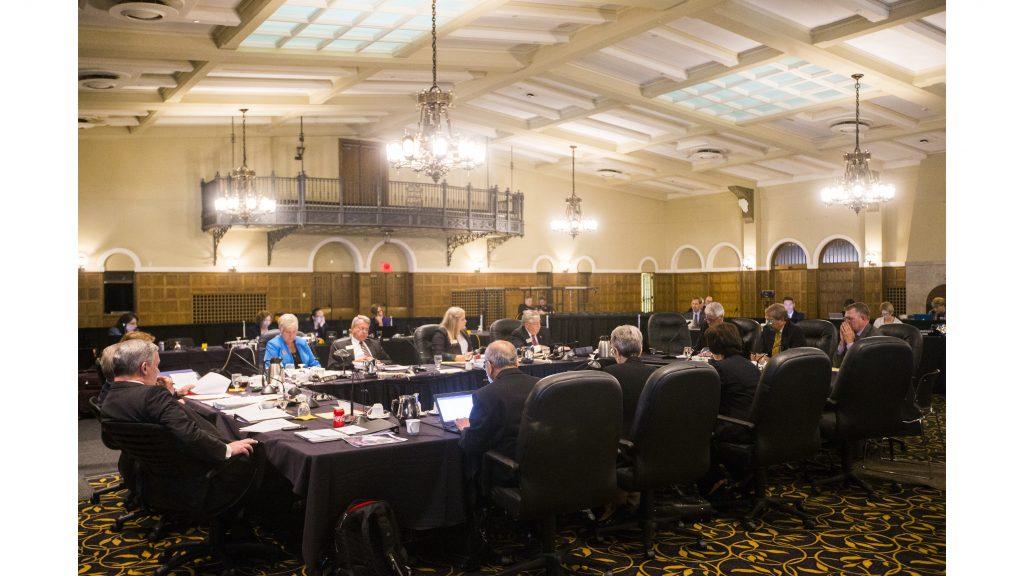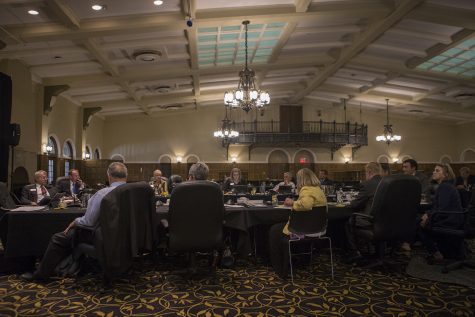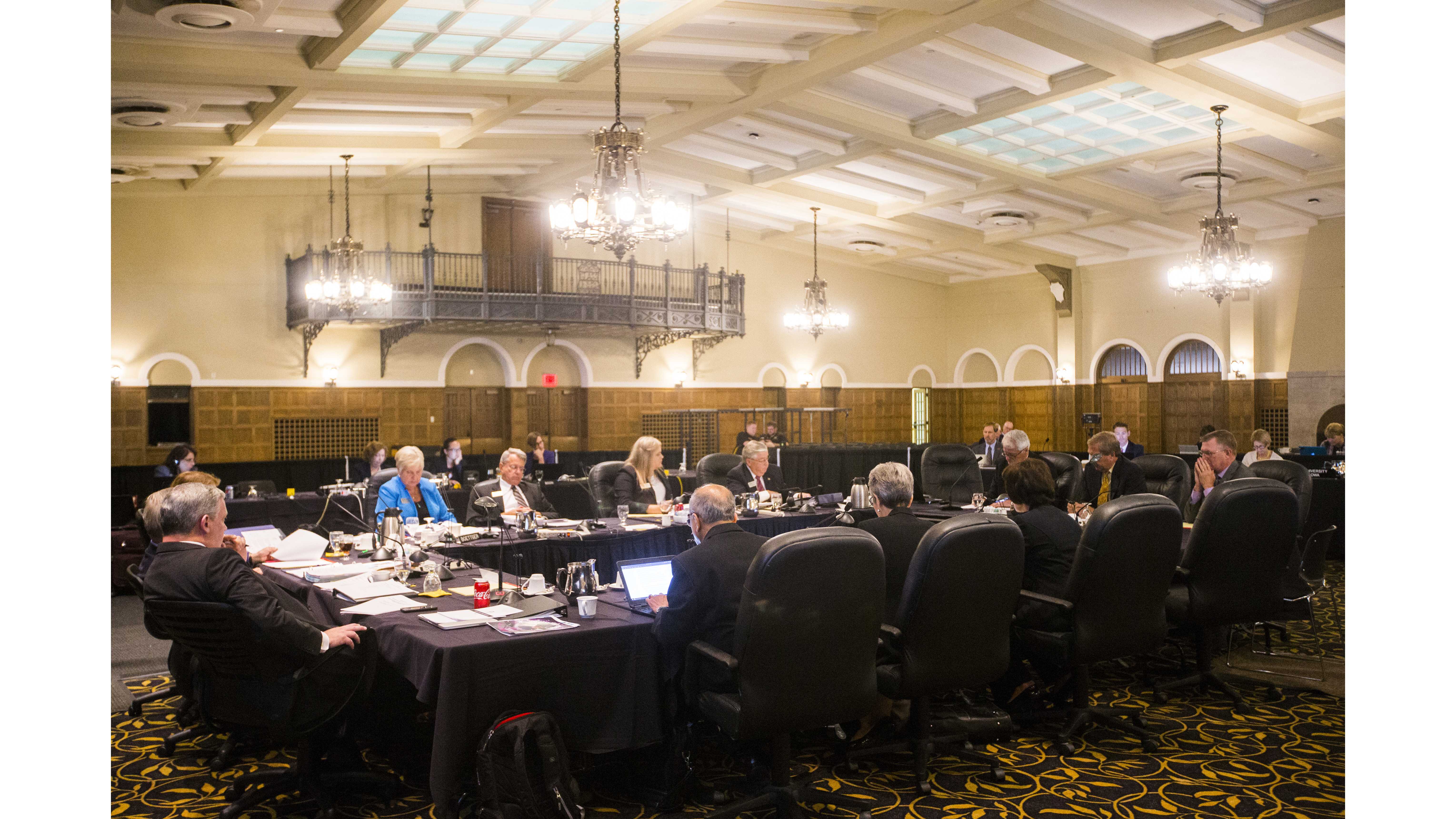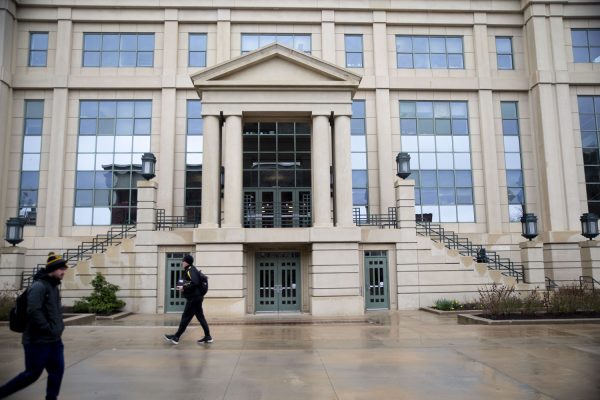Regents discuss decrease in university enrollment, future of higher education
As the state Board of Regents addresses a nationwide decrease in university enrollment, UI officials continue efforts to manage enrollment growth.
Regents listen to a presentation during a state Board of Regents meeting in the IMU main lounge on Thursday, Sept. 7, 2017.
November 15, 2018
Public universities across the United States have witnessed a decrease in enrollment for the last six years, and while many institutions may consider this a threat to higher education, University of Iowa officials say the decline only reinforces the university’s intent to manage enrollment growth.
At the state Board of Regents meeting on Thursday in Cedar Falls, regents heard a report that showed in recent years, enrollment has started to trail off, with a slight decline in the fall of 2017 from the previous year and a sharper drop of 2.8 percent this past fall since 2017.
Overall, four-year public universities in Iowa have seen a 10-percent increase in enrollment in 10 years despite a nationwide enrollment recession.
“Even in decline, this year marks the fourth-largest enrollment in regents’ history,” Associate Chief Academic Officer Jason Pontius said. “A lot of recent articles about enrollment have a note of panic in them. I want to throw in an alternative explanation.”
Pontius attributed the ultimate drop in university enrollment to increased competition for international students from Asia, difficulty in obtaining visas for students in a number of countries, and the growing notion that a rewarding future is not contingent upon a college degree.
“The majority of good jobs are those with a good bachelor’s degree or higher,” Pontius said. “A big challenge for the universities is making sure the B.A. path is available and affordable.”
RELATED: University of Iowa enrollment down after intentional growth management
He pointed out that enrollment of international students has declined, with enrollment of Chinese students specifically falling 28 percent at regent universities since the fall of 2015.
In addition, nonresident student enrollment fell at the UI by 7 percent in one year, with a similar drop at the University of Northern Iowa and a 2.2 percent increase at Iowa State University.
“It’s hard to get a clear picture of what’s happening,” Pontius said. “International students are down across the board. Out-of-state students are coming from neighboring states and really populous states.”
While ISU and UNI saw a decrease in resident student enrollment, the report noted, enrollment of that population is up at the UI. Compared with neighboring Midwestern states, Iowa public schools show fairly stable numbers of high-school graduates and several who choose to stay in Iowa.
Although the number of freshmen registered at the UI fell by 4.4 percent in the fall of 2017, Pontius said incoming classes are the primary driver for enrollment. According to the report, the UI has met strategic goals by encouraging and promoting resident enrollment.
“This fall, we got exactly the freshman class we wanted,” Associate Vice President for Enrollment Management Brent Gage previously told The Daily Iowan. “It was the most academically talented class we’ve ever enrolled in the history of the University of Iowa and maintained our diversity.”
UI officials hope to pay more attention to applicants to the university based on data to determine how many incoming freshmen the university needs and predictive modeling that shows early on if high-school students are likely to attend the university.
“We are in control,” Gage said. “We feel like it’s the right thing to do, because at the end of the day we want to make graduates, not freshmen.”
As a public institution serving a small-population state, Gage said, the admission process ultimately needs to be transparent and provide as much access to residents as possible. The goal should not be growth, he said, but equality in exceptional education.
UI President Bruce Harreld told the regents in September that size reduction is a way to ensure sufficient resources are allocated per student.
“The University of Iowa growth in the size of our student body is not a strategic priority,” he said. “Our main pursuit is excellence and outcomes.”





















